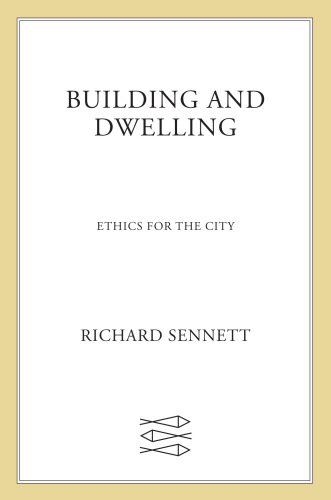
Building and Dwelling
Ethics for the City
کتاب های مرتبط
- اطلاعات
- نقد و بررسی
- دیدگاه کاربران
نقد و بررسی

February 1, 2018
Why more ethical and open cities represent the future of urban planning.The acclaimed urbanist and sociologist Sennett (Urban Studies/London School of Economics, Harvard Univ.) completes his Homo faber, or "man the maker," trilogy (The Craftsman, 2008, and Together: The Rituals, Pleasures, and Politics of Cooperation, 2012) with this exhaustively researched and illuminating inquiry that "seeks to connect how cities are built to how people live in them." It's also a window into one of the more brilliant and creative minds of our time. The author first establishes some groundwork for his investigation by setting forth the concepts of the ville, the overall city, and the cite, or a particular place. For example, the "traffic jams at the poorly designed tunnels" into New York City represents the ville, while the "rat race driving many New Yorkers to the tunnels at dawn" is the cite. Sennett expertly synthesizes vast amounts of information on urban design and other matters and explains them metaphorically. He looks at how urbanism, the "professional practice of city-making," has evolved by examining three 19th-century makers: architect Ildefons Cerda in Barcelona; Baron Haussmann, who remade Paris; and Frederick Law Olmsted, who tried to assert the "social value of nature in the city" by creating Central Park. Sennett finds each's plan "insufficient to solve the problems it addressed." The author next discusses the Jane Jacobs-Lewis Mumford debate and their differing versions of the open city. Sennett's quest to understand what an open city could look like takes him around the world, from Venice and Nehru Place in Delhi to Shanghai and Googleplex's "lair" in New York City. He learns something new from all of them. As a writer and thinker, Sennett is as comfortable discussing Balzac and Stendhal as he is plumbing the depths of theorists like Gaston Bachelard and Louis Althusser.A wide-ranging and learned work that celebrates the city as rich, engaged, tolerant, and alive.
COPYRIGHT(2018) Kirkus Reviews, ALL RIGHTS RESERVED.

February 19, 2018
The latest study from sociology professor Sennett (The Craftsman) focuses on the challenges of urban living throughout history with mixed results. Sennett begins by invoking the dichotomy between the city as built form (ville) and the city as lived experience (cité), before segueing to his central question: how should urban planners respond to the fundamental disjuncture between the built environment and the complex, messy social realities that spill over its manicured boundaries? Sennett explores the ways in which thinkers ranging from Ildefons Cerdà and Immanuel Kant to Jane Jacobs and Lewis Mumford sought to find a balance between an idealized provincial community and an indifferent cosmopolitan metropolis, weaving in insights from his own career as an urban planner, particularly pertaining to the concept of ethical urbanism. The book provides a lucid history of the major
currents of urbanism, drawing different moments in planning history together around a series of problems that bear directly on contemporary debates. Later sections on building the ethical city are less successful, a ponderous mash-up of observations about “street-smarts” and philosophical musings that fail to illuminate the “open city” of the future. The book is a learned study of city life in the past but is less convincing about what the future might hold.

March 15, 2018
Sennett (sociology & urban studies, London Sch. of Economics) completes his Homo Faber trilogy (after The Craftsman and Together: The Rituals, Pleasures, and Politics of Cooperation) by considering man as a creator of culture. In this latest work, the author examines the built environment, contrasting closed cities, comprised of walls or boundaries, with open cities, composed of porous borders. He uses the French words ville and cité to explore aspects of closed and open cities and the neighborhoods within them, contrasting the ideas of Le Corbusier, a pioneer of modern high-rise architecture, and his intellectual heir, Robert Moses, to those of Jane Jacobs (Death and Life of Great American Cities), an outspoken critic of urban renewal. Sennett enlivens theories of urban planning with descriptions of how life changed with new innovations. For example, after the pissoir (urinal) was invented, outdoor cafés appeared along the streets of Paris. VERDICT Combining accounts of city planning through history and across the globe with informal encounters with urban dwellers, this book will be of particular interest to sociologists and urban planners.--Caren Nichter, Paul Meek Lib., Univ. of Tennessee at Martin
Copyright 2018 Library Journal, LLC Used with permission.

Starred review from April 15, 2018
Sennett, a leading public intellectual since publication of The Fall of Public Man (1977), now offers a comprehensive inquiry into city building and city life. The ostensible aim of this demanding, richly argued book is to defend the open city, a place of ambiguity, complexity, and possibility, against the forces of standardization and regimentation. But this synopsis does little justice to Sennett's layered analysis, which spans literature, social mores, infrastructure, and community life. He deftly meanders from ancient Rome to modern Shanghai, from kindred spirits Lewis Mumford and Jane Jacobs to Mr. Sudhir, a Delhi cell-phone hawker, as he articulates a freer, messier, and more equitable approach to planning and living in cities. Sennett's virtuosic knack for linking incongruent evidence?say, interpreting Google's cushy New York offices through the lens of Tocqueville's Democracy in America?enlightens and delights in equal measure. What emerges is a passionate defense of urban forms that deepen residents' lives. In the city, Sennett writes, Complexity enriches experience; clarity thins it. The same might be said of this evocative work, in the best sense. A timely, challenging, and edifying book that beckons the reader to return.(Reprinted with permission of Booklist, copyright 2018, American Library Association.)

























دیدگاه کاربران